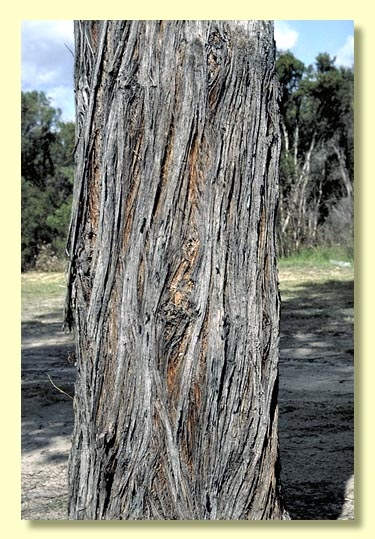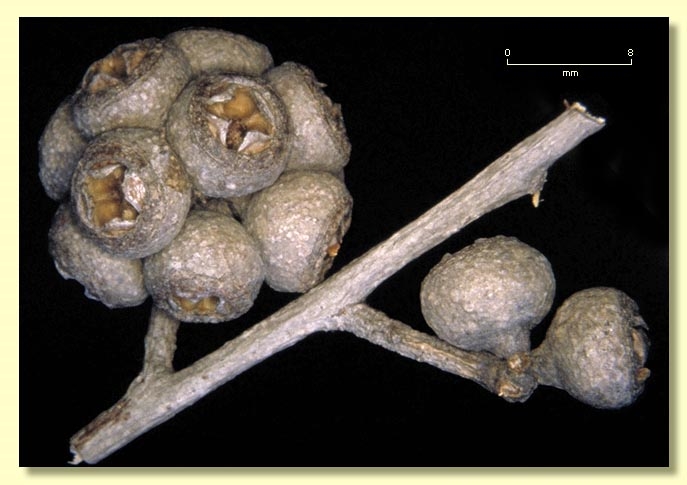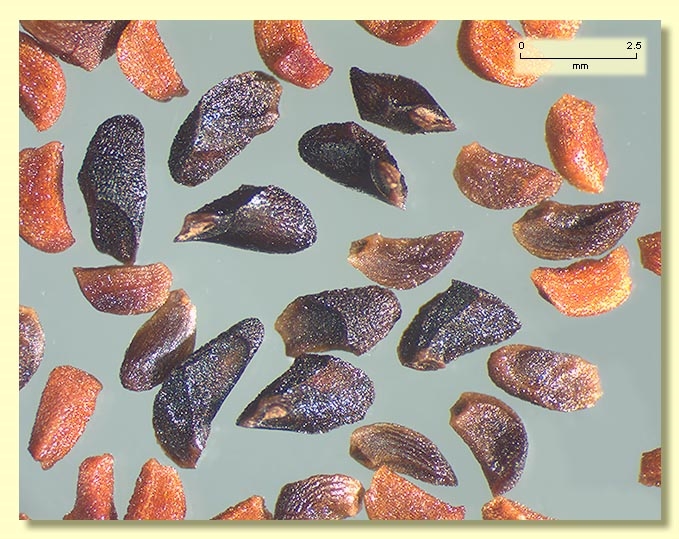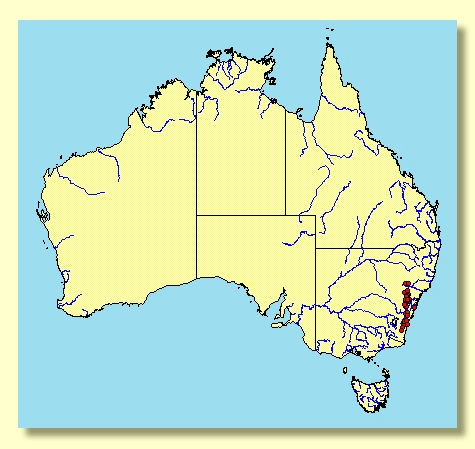Euclid - Online edition
Eucalyptus blaxlandii
Eucalyptus | Eucalyptus | Capillulus | Pachyphloius
T: Blackheath, NSW, Jan. 1905, J.H.Maiden s.n.; holo: NSW.
Bark rough on trunk and branches > 10cm diameter, stringy, dark brown to grey-brown, branches smooth-barked, whitish.
Juvenile growth (coppice or field seedlings to 50 cm): stem rounded in cross-section, scabrid; juvenile leaves petiolate, opposite for 6 or 7 pairs then alternate, ovate to lanceolate, 4–8 cm long, 1.5–4 cm wide, margin entire or appearing irregular due to marginal hairs but usually not undulate, discolorous, glossy, green, scabrid for many nodes.
Adult leaves alternate, petiole 0.5–1.7 cm long; blade lanceolate, 6–12 cm long, 1.3–2.7 cm wide, base oblique, concolorous, slightly glossy, green, side-veins acute, sparsely reticulate, intramarginal vein parallel to and well removed from margin, oil glands mostly island, irregular.
Inflorescence axillary unbranched, peduncles 0.5–1.4 cm long, buds in umbels of 9 to ?15, pedicels 0–0.3 cm long. Mature buds obovoid to oblong, 0.6 cm long, 0.3–0.4 cm wide, green, slightly angled, scar absent, operculum rounded, stamens irregularly flexed, anthers reniform to cordate, versatile, dorsifixed, dehiscing by confluent slits, style long, stigma tapered, locules 3 or 4, the placentae each with 2 vertical ovule rows. Flowers white.
Fruit sessile, hemispherical, 0.4–0.6 cm long, 0.7–1.3 cm wide, disc raised-convex or level, valves 3 or 4, slightly exserted or near rim level.
Seeds dark brown, blackish to grey, 1.5–2.5 mm long, pyramidal or obliquely pyramidal, dorsal surface smooth, hilum terminal.
Cultivated seedlings (measured at ca node 10): cotyledons reniform; stems rounded in cross-section, densely stellate-hairy; leaves always petiolate, opposite for 4 to 7 nodes then alternate, ovate, 4.5–8 cm long, 2–4.5 cm wide, base rounded to tapering, margin scarcely undulate, discolorous, glossy, mid-green above, paler beneath, sparsely stellate-hairy above, more so below.
Flowering has been recorded in March and November.
A medium-sized to tall stringybark tree that occurs from the Central Tablelands and the northern part of the Southern Tablelands of New South Wales, on sandstone-derived soils. Eucalyptus blaxlandii has conspicuously smooth, usually whitish branches, a green crown, glossy buds with rounded opercula and large crowded fruits with an hemispherical base slightly deformed laterally by compression, and a prominent usually ascending disc with valves not much exserted. Juvenile leaves on coppice growth are ovate-lanceolate and scabrid for many pairs.
E. blaxlandii differs from all other stringybark species within or near its natural range by the smooth-barked outer branches in the crown, other species being rough-barked to the small branches. E. agglomerata differs further in having pointed buds, more laterally compressed fruit and a bluish green crown, whilst E. capitellata, E. globoidea and E. eugenioides all have buds with pointed opercula. The taller-growing forest stringybark E. muelleriana has buds with rounded opercula like E. blaxlandii but differs in the fruit, which is obviously pedicellate and not closely aggregated in a cluster, and juvenile leaves that become glabrous very early in coppice growth. E. imitans differs from E. blaxlandii in having pointed or apiculate buds that are minutely warty or scurfy, not glossy, and juvenile leaves that are more coarse-textured and are scabrid only for the first ca 10 pairs.
MORE ABOUT STRINGYBARKS













